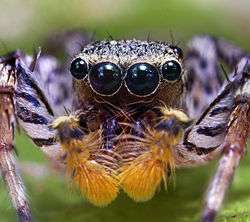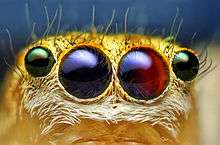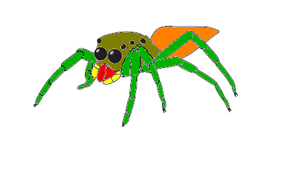Maevia inclemens
| Maevia inclemens | |
|---|---|
 | |
| Male Maevia inclemens - gray morph | |
| Scientific classification | |
| Kingdom: | Animalia |
| Phylum: | Arthropoda |
| Class: | Arachnida |
| Order: | Araneae |
| Family: | Salticidae |
| Genus: | Maevia |
| Species: | M. inclemens[1] |
| Binomial name | |
| Maevia inclemens (Walckenaer, 1837) | |
| Synonyms | |
|
12 synonyms, listed at [a] | |
Maevia inclemens is a relatively common and colorful jumping spider of North America. In the males there are two forms, a very rare phenomenon in zoology.[2] These use different courting displays,[3]:3-4 and differ in appearance: the "tufted" morph has a black body and pedipalps ("palps"), three black tufts across its "head", and pale legs; and the "gray" morph has black and white stripes all over its body and legs, orange palps, and no tufts.[2] However, each form accounts for 50% of the adult males, and they are equally successful in mating. A female of Maevia inclemens is 6.5 to 8.0 millimetres (0.26 to 0.31 in) long, while males are 4.75 to 6.50 millimetres (0.187 to 0.256 in) long.[3]:3-4
Like all jumping spiders, M. inclemens has excellent vision. The main eyes, in the front-and-center position, are large, and are more acute than those of a cat and about 10 times as acute as a dragonfly's. The remaining three pairs of eyes are along the sides of the head, and work as motion detectors. The eyes are used for hunting, for avoiding threats and for finding and wooing mates. Almost all jumping spiders are predators, mostly preying on insects, on other spiders, and on other arthropods.
M. inclemens is one of the 11 species in genus Maevia.[1] The species was first called Attus inclemens, and other names have been used. The two male forms look and behave so differently that they were originally considered two distinct species. In 1955 Robert Barnes chose M. inclemens,[3]:1 and this has become the standard name.[1]
The species is found in west southern Canada, and in the United States its distribution forms a crescent from the north mid-west through New England and south to Florida. M. inclemens has been able to establish itself in man-made structures such as outbuildings or fences.
Taxonomy
Maevia inclemens is the type species for the genus Maevia (C.L. Koch, 1850), [3]:2-3 which includes another 10 species in May 2011.[1] The species name is derived from Latin adjective inclēmens "cruel, harsh" or "rough".[4] The species was first called Attus inclemens, and other names including Attus vittatus, Maevia pencillata, and Maevia vittata.[a][3]:2-3 Also the two male forms look and behave so differently that they were originally considered two distinct species.[5] In 1955 Robert Barnes chose M. inclemens,[3]:1 and this has become the standard name.[1]
Description
Spiders are chelicerates, which differ from other arthropods in that the usual body segments are fused into only two tagmata, the cephalothorax and abdomen.[6] Spiders' abdomens bear appendages that have been modified into spinnerets that extrude silk from up to six types of silk glands within their abdomen. The cephalothorax and abdomen are joined by a small, cylindrical pedicel, which allows the abdomen to move while spinning silk.[7]:571-574 While most jumping spiders do not build webs to catch prey, they use silk for other purposes,[8] including molting and laying eggs.[9]:495
Jumping spiders have large forelegs and short, powerful back legs.[10] Unlike most arthropods, spiders have no extensor muscles in their limbs and instead extend them by increasing their blood pressure. Jumping spiders can leap several times their own length by powerfully extending the third or fourth pairs of legs,[7]:578 reaching up to 200 millimetres (7.9 in) with the forelimbs extended to grasp the prey.[8] Spiders maintain balance when walking, so that legs 1 and 3 on one side and 2 and 4 on the other side are moving, while the other four legs are on the surface. To run faster, spiders increase their stride frequency.[11]:328
In spiders and other chelicerates, there is only one pair of appendages before the mouth,[6] and in spiders these are modified into fangs that inject poison into the prey.[7] Behind the mouth is a pair of pedipalps ("palps" for short),[6] and those of male spiders are quite large and are used for displaying and mating.[7]
Spiders groom themselves regularly, and more often if wet or dirty. They moisten their fangs, draw the legs one at a time through the fangs, and "comb" the legs with the fangs and palps. The first and fourth pairs of legs are then used to groom other parts of the body, and the only place they appear not to reach is the dorsal surface of the carapace.[12]:53
The body of M. inclemens is only sparsely covered with hairs and scales.[3]:2 A female of Maevia inclemens is 6.5 to 8.0 millimetres (0.26 to 0.31 in) long,[3]:3-4 her carapace is light brown, her legs are pale and unmarked. The top of her abdomen is chalky[3]:3-4 or rusty colored,[2] and along each side is a black band, often thinly covered with orange scales. Sometimes there is series of chevrons (V-shaped markings) along the middle of her abdomen.[3]:3-4 She has a prominent white stripe below the foremost eyes.[2] There are spines on the first and second pair of her legs, but her body never has tufts of hair.[3]:3-4 Males are 4.75 to 6.50 millimetres (0.187 to 0.256 in) long, and their carapaces are light to dark brown, with a black line around the edge. There usually is a pair of large lighter areas between the last pair of eyes halfway down the back of the carapace. The eyes are surrounded by black. [3]:3-4 Males occur in two forms, a very rare phenomenon in zoology. The "tufted" morph has a totally black body, black pedipalps, white legs and three tufts of bristles on the front part of the cephalothorax. The "gray" male morph has a black and white striped body, a prominent white stripe on the foremost eyes, striped legs and bright orange pedipalps, and no tufts.[2][13]:161-162
Jumping spiders have a distinctive rectangular carapace,[12]:51 and that of female Maevia inclemens average 2.30 millimetres (0.091 in) wide, while the carapaces of males average 2.10 millimetres (0.083 in).[14]:1989 The carapace of M. inclemens is fairly high, between 60% and 70% of the width.[3]:1
Senses

Jumping spiders have eight eyes, the two large ones in the center-and-front position (the anterior-median eyes, also referred to as "principal eyes"[12]:51) providing acute vision and housed in tubes in the head. The other six are secondary eyes, positioned along the sides of the carapace and acting mainly as movement detectors.[15][16]:16 While other spiders can jump, salticids including M. inclemens are the only spiders with good vision,[17]:521[18] and their main eyes are more acute in daylight than a cat's and 10 times more acute than a dragonfly's.[15] The main eyes focus accurately on an object at distances from approximately 2 centimetres (0.79 in) to infinity,[12]:51 and in practise can see up to about 75 centimetres (30 in).[12]:53 In M. inclemens, the front row of secondary eyes is only slightly wider than the third, whose width is 75% of the width of the carapace at that point.[3]:2
Like other arthropods, spiders have sensors, often modified setae (bristles), for smell, taste, touch and vibration, protruding through their cuticle ("skin").[19]:532-533 Unlike insects, spiders and other chelicerates do not have antennae.[6][20]
Feeding
Almost all jumping spiders are predators, mostly preying on insects, on other spiders, and on other arthropods.[18] The most common procedure is sighting the prey, stalking, fastening a silk safety line to the surface, using the two pairs of back legs to jump on the victim, and finally biting the prey.[21] Most jumping spiders walk throughout the day, so that they maximize their chances of a catch.[22]
Reproduction and lifecycle
Each morph accounts for 50% of the adult males, and they make the same number of attempts to court females, but using a different courting display.[2] Before looking for a mate, a male spider spins a small, flat web on a surface and ejaculates into it. He then loads the semen into syringe-like receptacles in both palps, and then searches for a female.[7]:581


After sighting a female, the tufted morph pushes himself as high as possible with the last three pair of legs, and claps with the foremost pair, while at the same time waving the palps up and down, and swinging the abdomen from side to side,[23]:95 usually about 9 centimetres (3.5 in) from the female.[13]:161-162 In contrast, the gray morph crouches down and points the foremost two pairs of legs directly forward, crosses the tips of the legs creating a triangle-like configuration, holds his orange-colored palps beneath his forward eyes, and glides back and forth in stationary or receding semi-circles in front of the female, [23]:95 at 3 centimetres (1.2 in) away.[13]:161-162 The movements of the two morphs are identical later in the sequence.[23]:95, 98
When receptive, females respond similarly to both male types: approach and settle; extend the foremost pair of legs or tap with them.[23]:99 Both male morphs typically end their initial display and start leg-clapping and zig-zag dancing.[23]:103, 106
When tufted males clap, females look towards them and display a greater number of tap displays to them than to the gray morph. Females also respond to tufted morphs' clapping more often by settling than for gray males.[23]:102 However, after the females look towards the males, gray males approach the female more often than the tufted male.[23]:102 Females often tip their abdomens from side to side.[23]:102
Finally the male mounts and copulates with the female. Afterward, the male generally dismounts and the two pair usually run away from each other. However, the male sometimes chases the female and tries to copulate again.[23]:103, 106
In an experiment, 12 tufted (52%) and 14 gray males (54%) copulated with females after courtship. At the end of copulation, females tried to capture and eat the males, but in the same experiment only one tufted and one gray male were killed. A count of offspring showed no differences in numbers of spiderlings from the two morphs. However, gray males got females' attention more quickly within 8 centimetres (3.1 in) while tufted males were quicker between 8 and 30 centimetres (3.1 and 11.8 in) from the females. The continuation of two male morphs may be an example of a mixed Evolutionarily Stable Strategy, in which both morphs are genetically determined by their fathers' morphs, and both are equally successful in their different ways.[2]
Distribution and habitat
Maevia inclemens is found throughout the eastern and mid-west United States and south-west Canada, including: Massachusetts, Connecticut, New York state, New Jersey, Pennsylvania, Maryland, West Virginia, Virginia, North Carolina, Florida, Alabama, Louisiana, Texas, Kansas, Kentucky, Indiana, Illinois, Michigan, Wisconsin,[3]:4 Quebec and Manitoba.[24]
A study reported in 1981 on one mature and three recently clear-cut sites in the southern Appalachian Mountains near Highlands, North Carolina. All specimens of spiders that hunt were collected on plants or webs above ground. Clear-cutting caused a marked decrease in the abundance of nine species and a marked increase in four species, while M. inclemens and six others showed no change.[25]:288, 291-292
A few jumping spider species, including M. inclemens, have been able to establish themselves in man-made structures. Most often these spiders are found on outbuildings or structures such as fences, rather than in permanently inhabited houses.[26]
Notes
a: ^ The full set of synonyms is: Attus inclemens, Attus ictericus, Attus protervus, Attus aspergatus, Attus vittatus, Attus niger, Maevia pencillata, Maevia annulipes, Plexippus undatus, Astia vittata, Attus petulans and Maevia vittata[3]:1-3
References
- 1 2 3 4 5 Platnick, Norman I.; Robert Raven; Toby Schuh; Ryan Choi (2011). "World Spider Catalog - Genus Maevia". The American Museum of Natural History. Retrieved 29 April 2011.
- 1 2 3 4 5 6 7 Clark, David L.; Brandon Biesiadecki (2002). "Mating success and alternative reproductive strategies of the dimorphic jumping spider, Maevia inclemens (Araneae, Salticidae)" (PDF). The Journal of Arachnology. 30: 511–518. doi:10.1636/0161-8202(2002)030[0511:msaars]2.0.co;2. Retrieved 20 April 2011.
- 1 2 3 4 5 6 7 8 9 10 11 12 13 14 15 16 Barnes, Robert D. (August 12, 1955). "North American Jumping Spiders of the Genus Maevia" (PDF). American Museum Novitates. The American Museum of Natural History (1746): 1–13. Retrieved 12 May 2011.
- ↑ Simpson DP (1979). Cassell's Latin Dictionary (5 ed.). London: Cassell Ltd. p. 296. ISBN 0-304-52257-0.
- ↑ Guarisco, Hank; Bruce Cutler; Kenneth E. Kinman (February 2001). "Checklist of Kansas Jumping Spiders". The Kansas School Naturalist. Emporia, Kansas: Emporia State University. 47 (1). ISSN 0022-877X. Retrieved 12 May 2011.
- 1 2 3 4 Ruppert, E.E., Fox, R.S. and Barnes, R.D. (2004). "Chelicerata: Form". Invertebrate Zoology (7 ed.). Brooks / Cole. p. 555. ISBN 0-03-025982-7.
- 1 2 3 4 5 Ruppert, E.E., Fox, R.S., and Barnes, R.D. (2004). "Chelicerata: Araneae". Invertebrate Zoology (7 ed.). Brooks / Cole. pp. 571–584. ISBN 0-03-025982-7.
- 1 2 Hillyard, Paul D. (2007). "Jumping spiders". The private life of spiders. New Holland Publishers. pp. 33–35. ISBN 978-1-84537-690-1. Retrieved 11 April 2011.
- ↑ Jackson, Robert R.; Susan E.A. Hallas (1986). "Predatory versatility and intraspecies interactions of spartaeine jumping spiders (Araneae, Salticidae): Brettus adonis, B. cingulata, Cyrba algerina, and Phaeacius sp. indet.". New Zealand Journal of Zoology. 13: 491–520. doi:10.1080/03014223.1986.10422979. ISSN 0301-4223. Retrieved 1 April 2011.
- ↑ Hogue, Charles Leonard (1993). "Jumping spiders". Latin American insects and entomology. University of California Press. p. 117. ISBN 978-0-520-07849-9. Retrieved 11 April 2011.
- ↑ Anderson, D.T. (1998). "The Chelicerata". In D.T. Anderson. Invertebrate Zoology (1 ed.). Oxford University Press Australia. p. 467. ISBN 0-195539-41-9.
- 1 2 3 4 5 Forster, Lyndsay M. (1977). "A qualitative analysis of hunting behaviour in jumping spiders (Araneae: Salticidae)" (PDF). New Zealand Journal of Zoology. 4: 51–62. doi:10.1080/03014223.1977.9517936. Retrieved 27 April 2011.
- 1 2 3 Uhl, Grabiele; Damian O. Elias (2011). "Communication". In Marie Elisabeth Herberstein. Spider Behaviour: Flexibility and Versatility. Cambridge University Press. ISBN 978-0-521-74927-5. Retrieved 29 April 2011.
- ↑ Prenter, John; Robert W. Elwood; W. Ian Montgomery (Dec 1999). "Sexual Size Dimorphism and Reproductive Investment by Female Spiders: A Comparative Analysis" (PDF). Evolution. 53 (6): 1987–1994. doi:10.2307/2640458. Retrieved 26 April 2011. Also at JSTOR (paywall)
- 1 2 Harland, Duane P.; Robert R. Jackson (2000). "'Eight-legged cats' and how they see - a review of recent research on jumping spiders (Araneae: Salticidae)" (PDF). Cimbebasia. Proceedings of the 6th International Colloquium of the African Arachnological Society. The African Arachnological Society. 16: 231–240. Retrieved 31 March 2011.
- ↑ Hill, David Edwin (October 2010). "Use of location (relative direction and distance) information by jumping spiders (Araneae, Salticidae, Phidippus) during movement toward prey and other sighted objectives" (PDF). Peckhamia. 83 (1): 1–103. ISSN 1944-8120. Retrieved 12 April 2011.
- ↑ Jarman, Elizabeth A.R.; Robert R. Jackson (1986). "The biology of Taieria erebus (Araneae, Gnaphosidae), an araneophagic spider from New New Zealand: silk utilisation and predatory versatility". New Zealand Journal of Zoology. 13: 521–540. doi:10.1080/03014223.1986.10422980. ISSN 0301-4223. Retrieved 1 April 2011.
- 1 2 Hoefler, Chad D.; Andy Chen; Elizabeth M. Jakob (2006). "The Potential of a Jumping Spider, Phidippus clarus, as a Biocontrol Agent" (PDF). J. Econ. Entomol. 99 (2): 432–436. doi:10.1603/0022-0493-99.2.432. ISSN 0022-0493. PMID 16686143. Retrieved 25 April 2011.
- ↑ Ruppert, E.E., Fox, R.S., and Barnes, R.D. (2004). "Arthropoda: Sense organs". Invertebrate Zoology (7 ed.). Brooks / Cole. pp. 532–537. ISBN 0-03-025982-7.
- ↑ Ruppert, E.E., Fox, R.S., and Barnes, R.D. (2004). "Chelicerata: Arachnida". Invertebrate Zoology (7 ed.). Brooks / Cole. pp. 559–564. ISBN 0-03-025982-7.
- ↑ Richman, David B. (2008). "Jumping Spiders (Class Arachnidae, Order Araneae, Family Salticidae)". In John L. Capinera. Encyclopedia of entomology. Springer. pp. 2066–2068. ISBN 978-1-4020-6242-1. Retrieved 11 April 2011.
- ↑ Forster, Lyn M. (Nov 1977). "Some factors affecting feeding behaviour in young Trite auricoma spiderlings (Araneae: Salticidae)". New Zealand Journal of Zoology. The Royal Society of New Zealand. 4: 435–442. doi:10.1080/03014223.1977.9517967. Retrieved 24 April 2011.
- 1 2 3 4 5 6 7 8 9 Clark, David L. (1994). "Sequence analysis of courtship behavior in the dimorphic jumping spider Maevia inclemens (Araneae, Salticidae)" (PDF). Journal of Arachnology. 22: 94–107. Retrieved 29 April 2011.
- ↑ Ehmann, William J. (December 2, 2002). "Conservation Biology of Special Concern Jumping Spiders (Araneae: Salticidae) of Minnesota" (PDF). Conservation Biology Research Grants Program. Minnesota Department of Natural Resources. Retrieved 28 April 2011.
- ↑ Coyle, Frederick A. (1981). "Effects of clear-cutting on the spider community of a Southern Appalachian forest" (PDF). Journal of Arachnology. 9: 285–298. Retrieved 29 April 2011.
- ↑ Cutler, Bruce (December 1990). "Synanthropic Salticidae of the Northeast United States" (PDF). Peckhamia. 2 (6): 91–92. ISSN 1944-8120. Retrieved 29 April 2011.
External links
| Wikimedia Commons has media related to Maevia inclemens. |
- Maevia inclemens at Salticidae.org
- Maevia inclemens species page at Bugguide.net
- Male Maevia inclemens at YouTube
